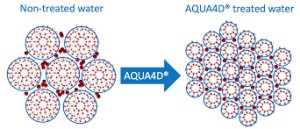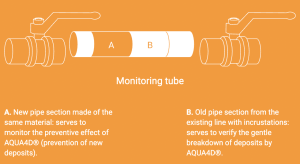Definition of Physical Water Treatments in Context with Other Types of Treatments
At Wikipedia one finds under the term “processes of water treatment” under physical processes actually chemical processes. So it says there e.g. aeration, atomization, sedimentation, flotation, adsorption. The water is enriched with gases, which directly changes its chemical composition. The goal is usually a change in the pH value. The mechanical or membrane processes would be closer to physical processes. These do not add anything to the water, but filter certain components out of the water. Mention should be made of membrane technologies, which have developed significantly in recent decades. In the meantime, these processes have become very important for seawater desalination for the production of drinking water. Newer, scientifically advanced methods, are otherwise found almost only in the type of water treatment described below. Otherwise, all the above-mentioned processes are mainly used in industry and for technically used water.
Today, physical processes are usually those which neither add to nor take away from the water. They only change the structure of the water, the interaction of the water molecules among themselves and with other ingredients contained in it. Such products are therefore suitable mainly for use in drinking water. For the most advanced systems, there are now precise explanations of how they work. However, anyone who is not familiar with water or has specialized knowledge of it will hardly be able to distinguish between the various products.
What are the physical processes?
Most often, physical water treatment systems are those that work with permanent magnets. In this case, magnets are simply attached to the outside of a water pipe. Then there are those that are more specifically designed and the magnets are integrated into a piece of pipe. These are then installed directly into the pipe. Electromagnetic systems are another method. Here, magnetic fields are generated with coils. Copper wires are wound around the line for this purpose. In these systems, the frequency of the power grid is usually used. On the one hand out of ignorance, since nature knows only direct current, or then out of convenience, since this frequency in the form of 50 Hz is just available.
Other approaches, with parts clamped to the outside of the pipe, work on the basis of ultrasound or “informed water”. The latter are probably best known under the name “Grander”. In others, minerals or crystal stones are attached to the pipe in small bags. Whereby the last-mentioned procedures still owe a comprehensible scientific explanation.
Mention should also be made of products based on sacrificial anodes and electrolysis, which are also sold as physical processes. If the customer expressly requests a physical process, some of these are offered by large companies today. However, these systems are electro-chemical in nature. Nevertheless, they are often offered only to make the customer believe that physical water treatments are not effective. This makes it easier for them to convince customers to install a water softener.
[ More about softeners in this article: Water Softeners in Residential Buildings: A Critical Appraisal ]
However, it must be clearly stated that magnetic and electromagnetic methods in particular are often effective and successful in preventing calcification. This is especially true in single-family houses and thanks to the short pipe lengths. However, the results cannot be achieved in the same way everywhere, as the pipe material, pipe dimensions and other parameters vary greatly from house to house. There are other reasons why systems that are clamped to the outside of the pipes have their limitations and the effect usually varies greatly. One of them is the flow velocity of the water through the magnetic fields.
However, the fact that magnetic fields can have an effect on water has been clearly demonstrated in many serious research papers around the world. The scientific explanations given by these researchers are that water clusters (clumps of water molecules) are reduced in size. Such a change can explain many of the altered properties of water. For example, why calcium and magnesium ions no longer crystallize on the inner walls of pipes, but around the small suspended particles thus released, forming many micro-crystals dissolved in the water. If water-molecule clusters become smaller, this results in a larger surface area for the molecules, which can thus better come into contact with other substances.
AQUA4D®: scientific basis and effect in practice over several kilometers of pipeline network.
The company AQUA4D has gone one step further in its scientific research and development work. The water molecules, which have dipole properties, can play out their natural electrical properties in larger numbers through smaller clusters. This allows ions, which are either negatively or positively charged, to be held in solution in much larger numbers. Combined with the precise resonant fields generated by this technology, they optimize the natural properties of water. As a result, ions can be transported in significantly higher numbers even as water temperatures rise. As a result, they no longer crystallize and can be easily removed even if the water evaporates after use. These properties have been substantiated thanks to university projects and by external scientists. For example, a recently published research paper by a French/Algerian institute shows how AQUA4D® can regenerate soils clogged by fertilizers. Macro- and micropores are created again in the soil by the treated water, which in turn can dissolve the solidified minerals. The same mode of action can also be used to break down existing limescale, corrosion and biofilm deposits in drinking water pipes.
Due to the specific resonance fields and signals which the AQUA4D® technology generates and is able to spread over several kilometers in the water, these systems are now leading in building services, agriculture and animal husbandry. Through the interaction of these parameters and through the company’s own know-how, they have been proven to promote biological build-up processes. The technology is highly sustainable, ecological, economical and water-saving. The list of corresponding quality labels and worldwide references in practice has become long.
Monitoring Tubes
Despite a great deal of positive scientific research, AQUA4D® has developed a simple yet convincing method in the Swiss building market to demonstrate the effectiveness of their systems and the condition inside the water pipes. This allows them to show property owners and the professionals involved, for each individual building, the progress in reducing existing incrustations and preventing calcification. This involves the plumbing contractor cutting an old, calcified and/or corroded piece of pipe out of the existing line. The condition on the day of installation is photographed and documented, and this piece of pipe is then reinstalled in the line. This is done simultaneously with the installation of the AQUA4D® system. After 12 and again after 24 months the control pipe is removed, photographed and compared with the original condition. The subsequent technical report of these inspections is available to all parties involved. Such control pipes are also planned from the beginning of new construction projects.
This very transparent control procedure is combined with a return guarantee should the success not materialize. Due to this unique transparency, which goes much further than the specifications required by the SVGW, this technology is trusted not only by apartment or house owners, but also by large property owners and management companies. The federal government, many cantons and municipalities as well as large insurance groups are now among its customers. The Canton of Valais even explicitly prescribes AQUA4D® in their own and subsidized buildings.
In our new webinar series, the various aspects are explained and discussed with invited experts. This always on a Tuesday in the middle of the month. There you can learn even more about this unique technology and perhaps deepen your knowledge about water and its treatment.
Switzerland
Sustainable Buildings
AQUA4D Webinar highlights: sustainable prevention of limescale and corrosion




